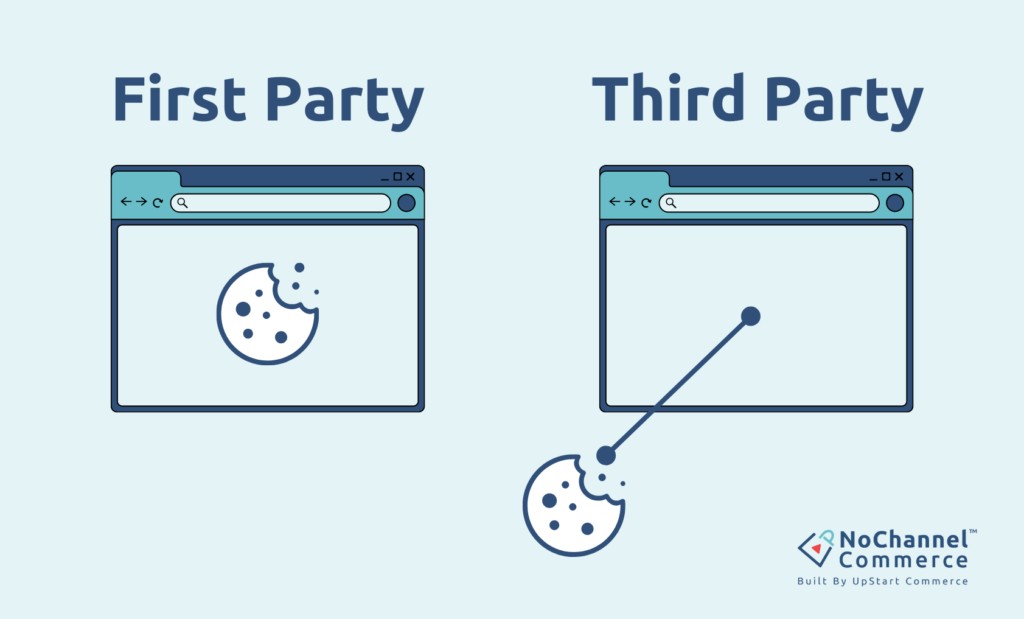The end of third-party tracking cookies has been a long-awaited shift for digital marketers and retailers alike. Many ecommerce marketers have been anticipating this change and preparing accordingly. If you have not started to adjust your marketing strategy to shift its focus from third-party to first party data, it’s not too late. Google has announced it will not end its support for third-party cookies until 2024. The blog will cover the importance of first party data, the difference between first party data and third-party cookies, and how to prepare for the shift coming in 2024.
How are Third-Party Cookies Used in Ecommerce Advertising?
Third-party cookies are used to track online advertising. Ecommerce marketers are no strangers to the importance of tracking the journeys of users who discover their products via online ads on platforms such as Google and Meta. They track users across the web, offering insights that fuel targeted ad campaigns, especially in the ecommerce sector. Such cookies have made personalized shopping experiences possible, effectively guiding customers down the purchase funnel. However, with the ending of third-party cookies, retailers need to adapt their marketing strategy to leverage first-party cookies (also called first party data and “HTTP cookies”).
The Difference Between Third-Party Cookies vs. First Party Data
First party data is limited to information gathered from website domains, while third-party cookies can be accessed by any website that loads the server code of the third-party. Both types of cookies are compatible with all browsers, and users have the ability to delete either type of cookie.

The Challenge of a Cookieless Future in Retail
Ecommerce thrives on understanding and predicting consumer behavior. Third-party cookies have played a major role in this. They’ve informed ad strategies, helped in retargeting, and more. But with their departure, there’s a massive data void left behind. So, how can retail and ecommerce marketers shift ahead of the change to better strengthen their marketing strategy?
How to Collect First Party Data
Marketers can gather first party data in a variety of ways:
- Newsletter subscriptions
- Lead generation campaigns
- Social media
- CRM
- Online customer support chats
- Customer feedback surveys
Data collected from these sources can be used in a variety of ways. The sooner your marketing strategy includes these touch points, the sooner you can start building up first party data on your customers. Each of these data points will give you deeper insights into your customers, from content preferences to shopping habits. This information will help inform your marketing decisions for 2024 and beyond.
Learn more: 5 Ecommerce Tips Retailers Need for October 2023
Maximizing the Benefits of First Party Data in Retail
First party data comes directly from your audience. Whether it’s transaction histories, newsletter sign-ups, or other on-site interactions, this data is purely yours. Integrating this data with tools like Google Analytics can lead to data-driven strategies that resonate with the audience. The key is to leverage the insights only you have about your customers to gain a competitive edge in paid search.
- Keyword Intent and User Journey
Even as third-party cookie tracking ends, understanding user intent remains a reliable strategy. Marketers can capture various user intents, from informational to transactional, by tailoring messaging and user journey strategies. Tools such as SEMRush and Moz can help retailers focus on keyword intent and restructure their forward-moving advertising strategy. This, combined with Google’s privacy-centric bidding algorithm, can help lift the challenges posed by the loss of third-party cookie data.
- Data Integration with Their CRM
With this change, marketers will be faced with the importance of connecting paid search to internal data sources, particularly a well-structured CRM system. Integrating data from various sources, such as Google Analytics, advertising platforms, and their CRM, can help maintain a holistic view of customer behavior. While the accuracy may not match that of previous cookies, a strategic approach to data integration can bridge the gap.
- Google Privacy Sandbox
An additional thing advertisers need to keep on their radar is Google’s ‘Privacy Sandbox’. It can help target and track campaigns post the third-party cookie era. The primary component, ‘Topics’, aggregates users’ interests based on their browsing history, thus presenting relevant ads. However, its true effectiveness and transparency are unknown.
Yes, the tracking cookie is crumbling. But that doesn’t mean it’s the end for digital marketing and advertising. Instead, it’s another pivot point. While third-party cookies fade, new solutions and methods are taking their place. Retailers and marketers that stay ahead of the curve, embracing changes and harnessing first party data, will not only survive but thrive in this modern landscape. Learn more about how our ecommerce solution can accelerate your ecommerce business.
